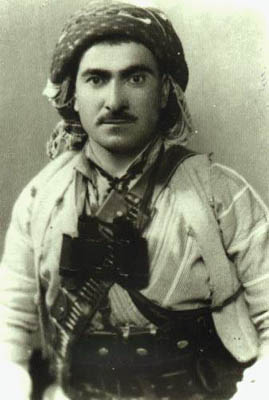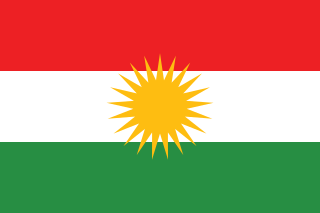
The Patriotic Union of Kurdistan is a political party active in Kurdistan Region and the disputed territories in Iraq. The PUK describes its goals as self-determination, human rights, democracy and peace for the Kurdish people of Kurdistan and Iraq. The PUK is currently under the leadership of Bafel Talabani. The PUK was founded in 1975 by Jalal Talabani, Nawshirwan Mustafa, Fuad Masum, Adel Murad, Ali Askari and Abdul Razaq Feyli. All presidents of Iraq under the 2005 constitution have been from this party.

Mustafa Barzani, also known as Mela Mustafa, was a Kurdish leader, general and one of the most prominent political figures in modern Kurdish politics.

The flag of Kurdistan is the flag of Kurds and was created by the Society for the Rise of Kurdistan in 1920. It would later, in different variants, be adopted as the national flag of different Kurdish states including Republic of Ararat, Republic of Mahabad and most recently by Kurdistan Region in 1992. Moreover, the Kingdom of Kurdistan used the crescent flag which was also considered a Kurdish flag.
Idris Barzani was a Kurdish politician in the Kurdistan Region. He was the brother of Massoud Barzani, the former president of the Kurdistan Region and the father of Nechervan Idris Barzani, the current president of the Kurdistan Region. He was often on diplomatic trips for the Kurdistan Democratic Party He died on January 31, 1987, of a heart attack.

The Democratic Party of Iranian Kurdistan, also known as the Kurdish Democratic Party of Iran (KDPI), is an armed leftist ethnic party of Kurds in Iran, exiled in northern Iraq. It is banned in Iran and thus not able to operate openly. The group calls for self-determination of Kurdish people, and has been described as seeking either separatism or autonomy within a federal system.
Kurds in Iran constitute a large minority in the country with a population of around 9 and 10 million people.

The Kurdistan Democratic Party, usually abbreviated as KDP or PDK, is the largest party in Iraqi Kurdistan and the senior partner in the Kurdistan Regional Government. It was founded in 1946 in Mahabad in Iranian Kurdistan. The party states that it combines "democratic values and social justice to form a system whereby everyone in Kurdistan can live on an equal basis with great emphasis given to rights of individuals and freedom of expression."

Nawshirwan Mustafa was an Iraqi Kurdish politician who served as the General Coordinator of the Movement for Change and the leader of the opposition in the Kurdistan Region from 1 April 2009 to his death on 19 May 2017.

Ali Askari (1936–1978) was a Kurdish politician, military leader, and revolutionary. He was a prominent leader in Iraqi Kurdistan and his political party was the Patriotic Union of Kurdistan (PUK).
The First Iraqi–Kurdish War also known as Aylul revolts was a major event of the Iraqi–Kurdish conflict, lasting from 1961 until 1970. The struggle was led by Mustafa Barzani, in an attempt to establish an independent Kurdistan. Throughout the 1960s, the uprising escalated into a long war, which failed to resolve despite internal power changes in Iraq. During the war, 80% of the Iraqi army was engaged in combat with the Kurds. The war ended with a stalemate in 1970, resulting in between 75,000 to 105,000 casualties. A series of Iraqi–Kurdish negotiations followed the war in an attempt to resolve the conflict. The negotiations led to the Iraqi–Kurdish Autonomy Agreement of 1970.
The Second Iraqi–Kurdish War was the second chapter of the Barzani rebellion, initiated by the collapse of the Kurdish autonomy talks and the consequent Iraqi offensive against rebel KDP troops of Mustafa Barzani during 1974–1975. The war came in the aftermath of the First Iraqi–Kurdish War (1961–1970), as the 1970 peace plan for Kurdish autonomy had failed to be implemented by 1974. Unlike the previous guerrilla campaign in 1961–1970, waged by Barzani, the 1974 war was a Kurdish attempt at symmetric warfare against the Iraqi Army, which eventually led to the quick collapse of the Kurds, who were lacking advanced and heavy weaponry. The war ended with the exile of the Iraqi KDP party and between 7,000–20,000 deaths from both sides combined.

The Iraqi–Kurdish conflict consists of a series of wars, rebellions and disputes by the Kurds against the central authority of Iraq starting in the 20th century shortly after the defeat of the Ottoman Empire in World War I. Some put the marking point of the conflict beginning to the attempt by Mahmud Barzanji to establish an independent Kingdom of Kurdistan, while others relate to the conflict as only the post-1961 insurrection by the Barzanis. Since the US-led invasion of Iraq and the subsequent recognition of the Kurdistan Region (KRI) the number and scope of armed clashes between the central government of Iraq and the Kurds have significantly decreased. In spite of that, however, there are still outstanding issues that continue to cause strife such as the disputed territories of northern Iraq and rights to oil and gas, leading to occasional armed clashes. In September 2023, Masrour Barzani sent a letter to the President of the United States expressing concerns about a possible collapse of the Kurdistan Region and calling for the United States to intervene.

The PUK insurgency was a low-level rebellion of the Patriotic Union of Kurdistan (PUK) against Baathist Iraq from 1975 to 1979, following the defeat of the Kurdistan Democratic Party (KDP) in the Second Iraqi–Kurdish War, which forced that organization to declare a ceasefire and move into exile in Iran. Due to lack of foreign support, the PUK guerrillas were only able to operate in the most remote parts of the mountains of Iraqi Kurdistan. During this period, the PUK plunged into a political crisis with the KDP, which led to heavy intra-Kurdish warfare, climaxing in 1977. After the insurgency, the PUK entered into an alliance with Iranian forces during the Iran–Iraq War, and were backed by Iran in the Kurdish rebellion of 1983.

Kurdish separatism in Iran or the Kurdish–Iranian conflict is an ongoing, long-running, separatist dispute between the Kurdish opposition in Western Iran and the governments of Iran, lasting since the emergence of Reza Shah Pahlavi in 1918.

The 1979 Kurdish rebellion in Iran was one of the largest nationwide uprisings in the country against the new state following the Iranian Revolution. The Kurdish rebellion began in mid-March, just two months after the Revolution ended, and was one of the most intense Kurdish rebellions in modern Iran.
The insurgency by the Kurdish Democratic Party of Iran surged in 1989, lasting until 1996, as part of the Kurdish separatism struggle. The eruption of the conflict in July 1989 was caused by the assassination of KDPI leader Abdul Rahman Qassemlou by suspected Iranian government agents. The most violent episodes took place in 1990 and 1991, when Kurdish soldiers launched massive attacks on Iranian military bases in Kurdish areas of Iran. This brought heavy retaliation from the Iranian government, aiming to eradicate the KDPI leadership by assassinating Sadegh Sharafkandi and other KDPI leaders in 1992 in order to disable the Kurdish party's ability to function. The conflict faded with the effective targeted assassination policy of Iran and by 1996 KDPI was no longer able to function militarily and announced a unilateral ceasefire. The conflict claimed hundreds of lives, mostly Iranian government troops and Kurdish militants.
The 1943–1945 Barzani revolt was a Kurdish nationalistic insurrection in the Kingdom of Iraq, during World War II. The revolt was led by Mustafa Barzani and was later joined by his older brother Ahmed Barzani, the leader of the previous Kurdish revolt in Iraq. The revolt, initiating in 1943, was eventually put down by the Iraqi assault in late 1945, combined with the defection of a number of Kurdish tribes. As a result, the Barzanis retreated with much of their forces into Iranian Kurdistan, joining the local Kurdish elements in establishing the Republic of Mahabad.
Suleiman Moini was an Iranian Kurdish political activist. After the collapse of the 1946 republic, the political activities of the Kurds in Iran declined. Some of the 1946 political activists to went to Iraqi Kurdistan and later joined the rebellion of Mustafa Barzani in the 1960s.
Abdullah Mohtadi is the leader and secretary general of Komala Party of Iranian Kurdistan.

The Kurdish mujahideen is a term used for Kurdish Islamists who fought for the establishment of "Kurdistan".











